flap VAUXHALL COMBO E 2020 User Guide
[x] Cancel search | Manufacturer: VAUXHALL, Model Year: 2020, Model line: COMBO E, Model: VAUXHALL COMBO E 2020Pages: 279, PDF Size: 28.6 MB
Page 81 of 279

Storage79
Turn the locking device upwards.
Put the hinges of the flap in their
housing, lift the flap and close the
locking device.
Fitting the protective cover
The protective cover must be
installed whenever the outer
passenger seat backrest is folded
down and the partition flap is open.
1. Fold the outer passenger seat backrest 3 47.2. Attach the four snap hooks of the
cover on the corresponding
lashing eye.
3. Pull the head restraint from the folded backrest, leaving two
notches visible on the head
restraint rod 3 44.
4. Load the objects.5. Pass the strap of the cover around
the head restraint. Tension the
strap by pulling at the loose end.
With fitted protective cover the
maximum load on the folded backrest is 100 kg.
Safety net
Depending on version, the safety net
can be installed behind the rear seats
or, if the rear seat backrests are
folded, behind the front seats.
Passengers must not be transported
behind the safety net.
Page 83 of 279
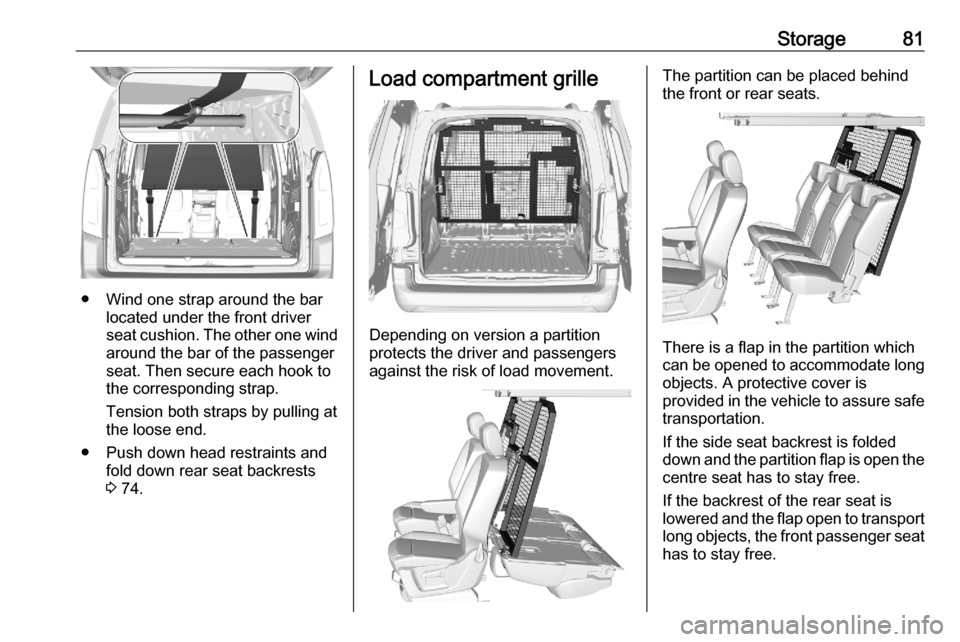
Storage81
● Wind one strap around the barlocated under the front driver
seat cushion. The other one wind
around the bar of the passenger
seat. Then secure each hook to
the corresponding strap.
Tension both straps by pulling at
the loose end.
● Push down head restraints and fold down rear seat backrests
3 74.
Load compartment grille
Depending on version a partition
protects the driver and passengers
against the risk of load movement.
The partition can be placed behind
the front or rear seats.
There is a flap in the partition which
can be opened to accommodate long
objects. A protective cover is
provided in the vehicle to assure safe transportation.
If the side seat backrest is folded
down and the partition flap is open the centre seat has to stay free.
If the backrest of the rear seat is
lowered and the flap open to transport
long objects, the front passenger seat
has to stay free.
Page 84 of 279
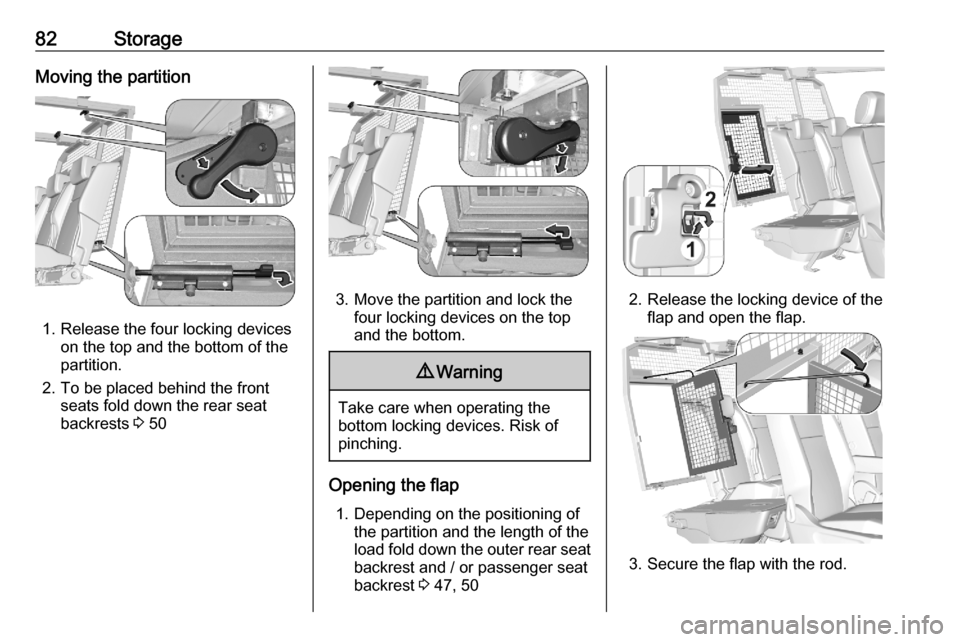
82StorageMoving the partition
1. Release the four locking deviceson the top and the bottom of the
partition.
2. To be placed behind the front seats fold down the rear seat
backrests 3 50
3. Move the partition and lock the
four locking devices on the top
and the bottom.
9 Warning
Take care when operating the
bottom locking devices. Risk of
pinching.
Opening the flap
1. Depending on the positioning of the partition and the length of the
load fold down the outer rear seat
backrest and / or passenger seat
backrest 3 47, 50
2. Release the locking device of the
flap and open the flap.
3. Secure the flap with the rod.
Page 85 of 279

Storage83Closing the flap1. Fix the rod in the bracket.
2. Close the flap and lock the locking
device.
3. Restore the seats to the upright position 3 47, 50
Fitting the protective cover
The protective cover must be
installed whenever the side seat
backrest is folded down and the
partition flap is open.
1. Attach the four snap hooks of the cover on the corresponding
lashing eye.
2. Pull the head restraint from the folded backrest, leaving two
notches visible on the head
restraint rod 3 44.
3. Load the objects.4. Pass the strap of the cover around
the head restraint. Tension the
strap by pulling at the loose end.
If the loading is stored on the front
and rear seat at the passenger
Page 156 of 279
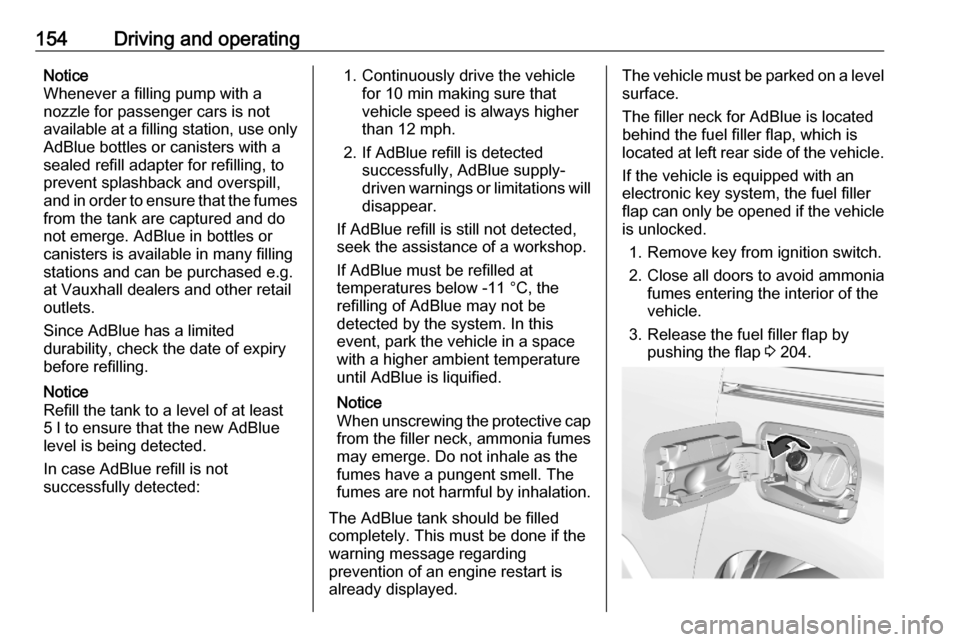
154Driving and operatingNotice
Whenever a filling pump with a
nozzle for passenger cars is not
available at a filling station, use only
AdBlue bottles or canisters with a
sealed refill adapter for refilling, to
prevent splashback and overspill,
and in order to ensure that the fumes
from the tank are captured and do
not emerge. AdBlue in bottles or
canisters is available in many filling
stations and can be purchased e.g. at Vauxhall dealers and other retail
outlets.
Since AdBlue has a limited
durability, check the date of expiry
before refilling.
Notice
Refill the tank to a level of at least
5 l to ensure that the new AdBlue
level is being detected.
In case AdBlue refill is not
successfully detected:1. Continuously drive the vehicle for 10 min making sure that
vehicle speed is always higher
than 12 mph.
2. If AdBlue refill is detected successfully, AdBlue supply-
driven warnings or limitations will
disappear.
If AdBlue refill is still not detected, seek the assistance of a workshop.
If AdBlue must be refilled at
temperatures below -11 °C, the
refilling of AdBlue may not be
detected by the system. In this
event, park the vehicle in a space
with a higher ambient temperature
until AdBlue is liquified.
Notice
When unscrewing the protective cap
from the filler neck, ammonia fumes
may emerge. Do not inhale as the
fumes have a pungent smell. The
fumes are not harmful by inhalation.
The AdBlue tank should be filled
completely. This must be done if the
warning message regarding
prevention of an engine restart is
already displayed.The vehicle must be parked on a level surface.
The filler neck for AdBlue is located
behind the fuel filler flap, which is located at left rear side of the vehicle.
If the vehicle is equipped with an
electronic key system, the fuel filler
flap can only be opened if the vehicle
is unlocked.
1. Remove key from ignition switch.
2. Close all doors to avoid ammonia fumes entering the interior of the
vehicle.
3. Release the fuel filler flap by pushing the flap 3 204.
Page 205 of 279
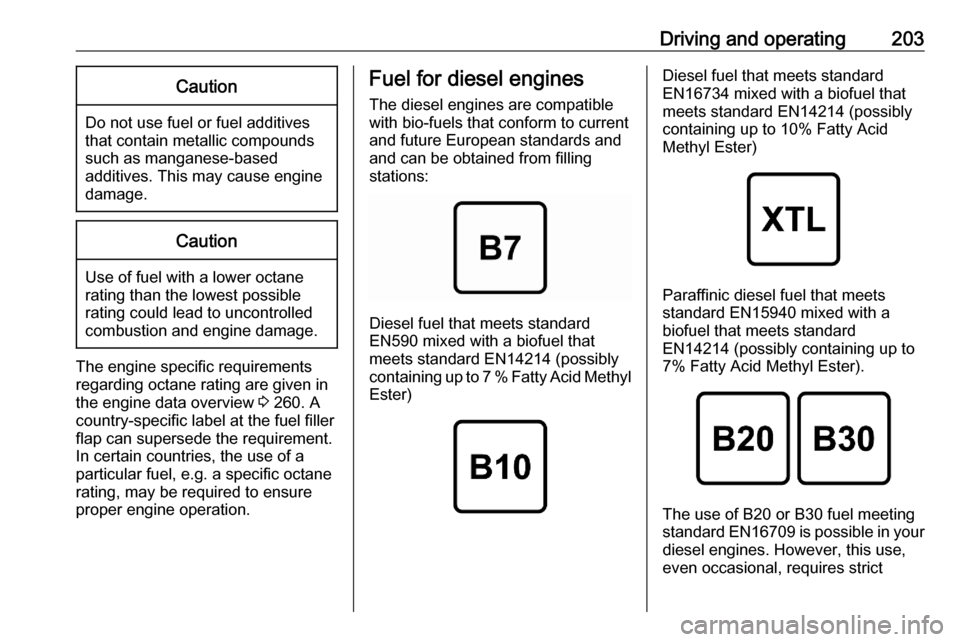
Driving and operating203Caution
Do not use fuel or fuel additives
that contain metallic compounds
such as manganese-based
additives. This may cause engine
damage.
Caution
Use of fuel with a lower octane
rating than the lowest possible
rating could lead to uncontrolled combustion and engine damage.
The engine specific requirements
regarding octane rating are given in
the engine data overview 3 260. A
country-specific label at the fuel filler
flap can supersede the requirement.
In certain countries, the use of a
particular fuel, e.g. a specific octane
rating, may be required to ensure
proper engine operation.
Fuel for diesel engines
The diesel engines are compatible
with bio-fuels that conform to current and future European standards and
and can be obtained from filling
stations:
Diesel fuel that meets standard
EN590 mixed with a biofuel that
meets standard EN14214 (possibly
containing up to 7 % Fatty Acid Methyl Ester)
Diesel fuel that meets standard
EN16734 mixed with a biofuel that
meets standard EN14214 (possibly
containing up to 10% Fatty Acid
Methyl Ester)
Paraffinic diesel fuel that meets
standard EN15940 mixed with a
biofuel that meets standard
EN14214 (possibly containing up to 7% Fatty Acid Methyl Ester).
The use of B20 or B30 fuel meetingstandard EN16709 is possible in your
diesel engines. However, this use,
even occasional, requires strict
Page 206 of 279
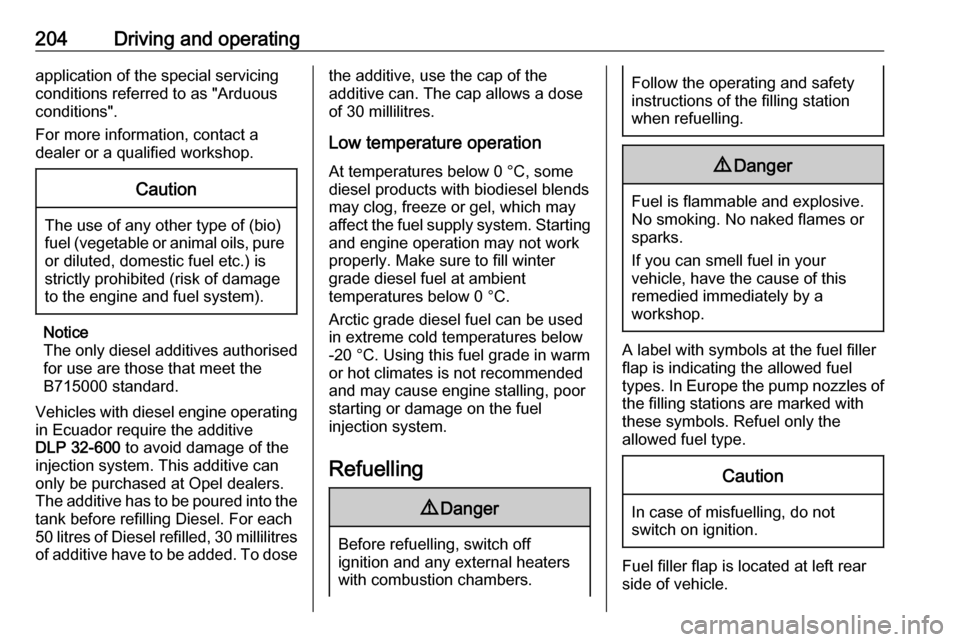
204Driving and operatingapplication of the special servicing
conditions referred to as "Arduous
conditions".
For more information, contact a
dealer or a qualified workshop.Caution
The use of any other type of (bio)
fuel (vegetable or animal oils, pure
or diluted, domestic fuel etc.) is
strictly prohibited (risk of damage
to the engine and fuel system).
Notice
The only diesel additives authorised for use are those that meet the
B715000 standard.
Vehicles with diesel engine operating
in Ecuador require the additive
DLP 32-600 to avoid damage of the
injection system. This additive can
only be purchased at Opel dealers.
The additive has to be poured into the
tank before refilling Diesel. For each
50 litres of Diesel refilled, 30 millilitres of additive have to be added. To dose
the additive, use the cap of the
additive can. The cap allows a dose
of 30 millilitres.
Low temperature operation At temperatures below 0 °C, somediesel products with biodiesel blendsmay clog, freeze or gel, which may
affect the fuel supply system. Starting
and engine operation may not work
properly. Make sure to fill winter
grade diesel fuel at ambient
temperatures below 0 °C.
Arctic grade diesel fuel can be used
in extreme cold temperatures below
-20 °C. Using this fuel grade in warm
or hot climates is not recommended
and may cause engine stalling, poor starting or damage on the fuel
injection system.
Refuelling9 Danger
Before refuelling, switch off
ignition and any external heaters
with combustion chambers.
Follow the operating and safety
instructions of the filling station
when refuelling.9 Danger
Fuel is flammable and explosive.
No smoking. No naked flames or
sparks.
If you can smell fuel in your
vehicle, have the cause of this
remedied immediately by a
workshop.
A label with symbols at the fuel filler
flap is indicating the allowed fuel
types. In Europe the pump nozzles of the filling stations are marked with
these symbols. Refuel only the
allowed fuel type.
Caution
In case of misfuelling, do not
switch on ignition.
Fuel filler flap is located at left rear
side of vehicle.
Page 207 of 279
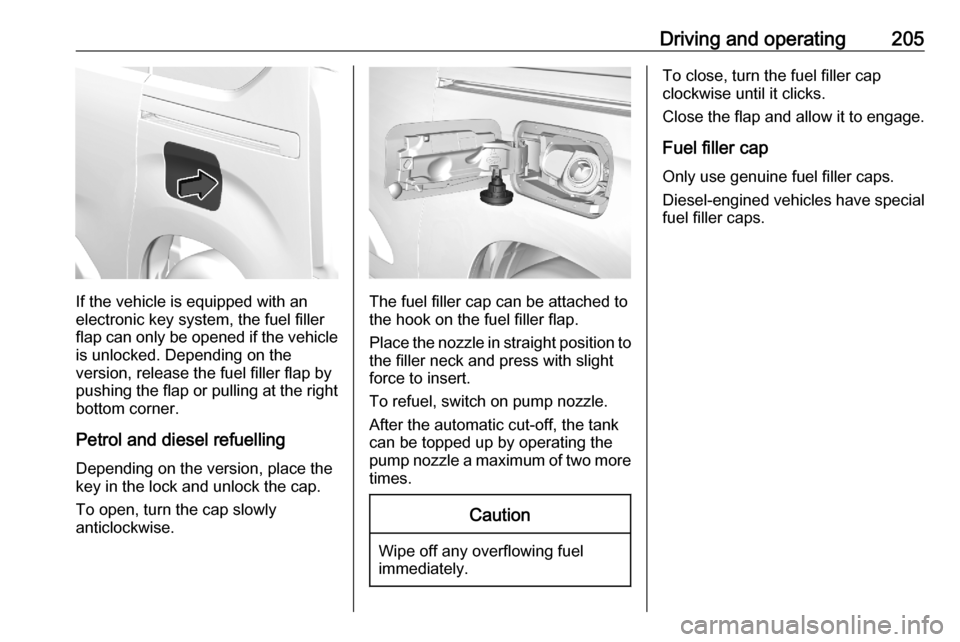
Driving and operating205
If the vehicle is equipped with an
electronic key system, the fuel filler
flap can only be opened if the vehicle
is unlocked. Depending on the
version, release the fuel filler flap by
pushing the flap or pulling at the right bottom corner.
Petrol and diesel refuellingDepending on the version, place the
key in the lock and unlock the cap.
To open, turn the cap slowly
anticlockwise.The fuel filler cap can be attached to
the hook on the fuel filler flap.
Place the nozzle in straight position to
the filler neck and press with slight
force to insert.
To refuel, switch on pump nozzle.
After the automatic cut-off, the tank
can be topped up by operating the
pump nozzle a maximum of two more times.
Caution
Wipe off any overflowing fuel
immediately.
To close, turn the fuel filler cap
clockwise until it clicks.
Close the flap and allow it to engage.
Fuel filler cap
Only use genuine fuel filler caps.
Diesel-engined vehicles have special fuel filler caps.
Page 210 of 279

208Driving and operating3. Insert the coupling ball bar in theopening and push firmly up to the
stop.
Secure the coupling ball bar
correctly by moving the lever to
the locked position, shown in the
picture.
4. Lock the coupling ball bar by turning the key. Remove the key
and close the protective flap.
5. Attach the trailer.
6. Fold the socket forward.
7. Connect the trailer plug to the socket.
8. Attach the breakaway stoppingcable to the eye on the carrier.
9 Warning
Towing a trailer is permitted only
when a coupling ball bar is fitted correctly. If the coupling ball bardoes not engage correctly, seekthe assistance of a workshop.
Dismounting coupling ball bar
1. Disconnect the trailer plug.
2. Unfasten the breakaway stopping
cable.
3. Remove the trailer.
4. Open the protective flap and unlock the coupling ball bar with
the key.
5. Move the lever of the coupling ball
bar to the rear position. Remove
the coupling ball bar by pulling it.
Page 214 of 279
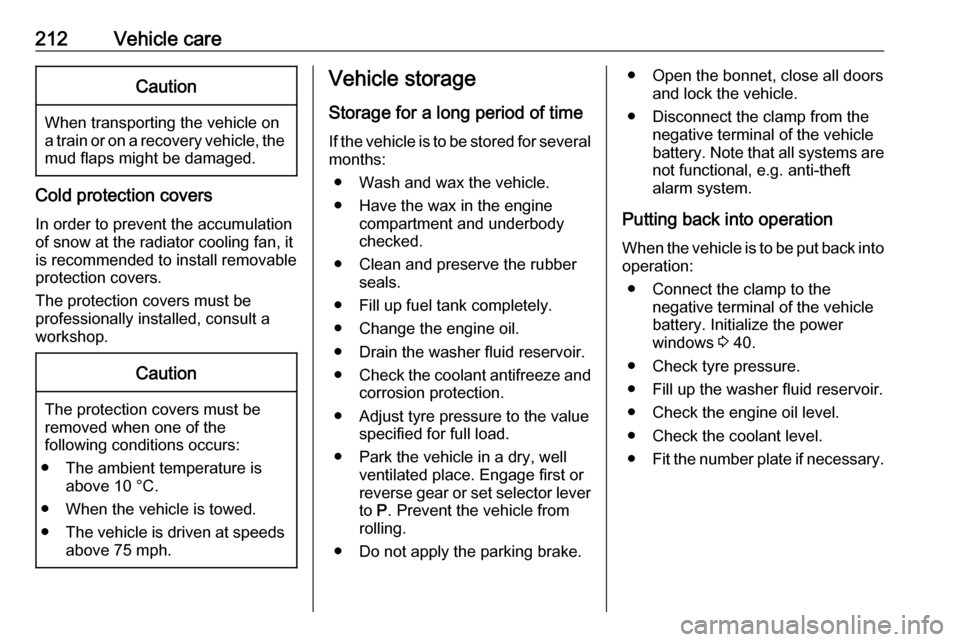
212Vehicle careCaution
When transporting the vehicle on
a train or on a recovery vehicle, the
mud flaps might be damaged.
Cold protection covers
In order to prevent the accumulation
of snow at the radiator cooling fan, it is recommended to install removable
protection covers.
The protection covers must be
professionally installed, consult a
workshop.
Caution
The protection covers must be removed when one of the
following conditions occurs:
● The ambient temperature is above 10 °C.
● When the vehicle is towed.
● The vehicle is driven at speeds
above 75 mph.
Vehicle storage
Storage for a long period of timeIf the vehicle is to be stored for several
months:
● Wash and wax the vehicle.
● Have the wax in the engine compartment and underbody
checked.
● Clean and preserve the rubber seals.
● Fill up fuel tank completely.
● Change the engine oil.
● Drain the washer fluid reservoir.
● Check the coolant antifreeze and
corrosion protection.
● Adjust tyre pressure to the value specified for full load.
● Park the vehicle in a dry, well ventilated place. Engage first or
reverse gear or set selector lever to P. Prevent the vehicle from
rolling.
● Do not apply the parking brake.● Open the bonnet, close all doors and lock the vehicle.
● Disconnect the clamp from the negative terminal of the vehicle
battery. Note that all systems are
not functional, e.g. anti-theft
alarm system.
Putting back into operation When the vehicle is to be put back into
operation:
● Connect the clamp to the negative terminal of the vehicle
battery. Initialize the power
windows 3 40.
● Check tyre pressure.
● Fill up the washer fluid reservoir.
● Check the engine oil level.
● Check the coolant level.
● Fit the number plate if necessary.